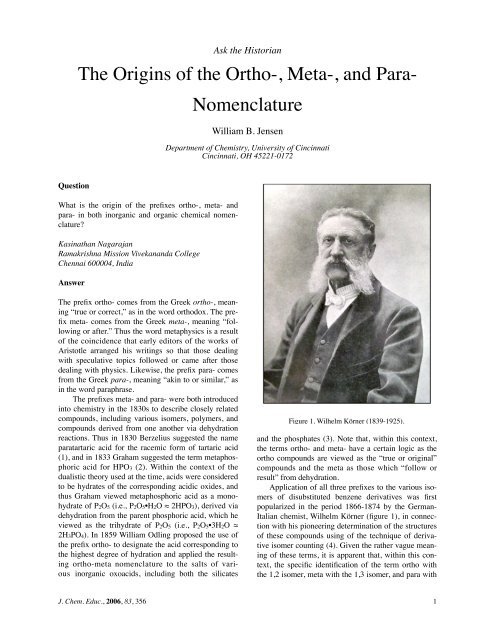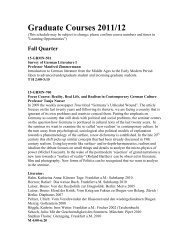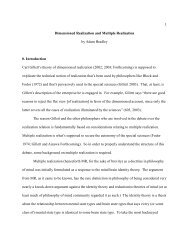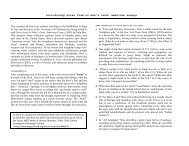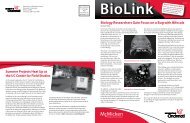126. Othro, Meta, Para.pdf - University of Cincinnati
126. Othro, Meta, Para.pdf - University of Cincinnati
126. Othro, Meta, Para.pdf - University of Cincinnati
Create successful ePaper yourself
Turn your PDF publications into a flip-book with our unique Google optimized e-Paper software.
Question<br />
What is the origin <strong>of</strong> the prefixes ortho-, meta- and<br />
para- in both inorganic and organic chemical nomenclature?<br />
Kasinathan Nagarajan<br />
Ramakrishna Mission Vivekananda College<br />
Chennai 600004, India<br />
Answer<br />
The prefix ortho- comes from the Greek ortho-, meaning<br />
“true or correct,” as in the word orthodox. The prefix<br />
meta- comes from the Greek meta-, meaning “following<br />
or after.” Thus the word metaphysics is a result<br />
<strong>of</strong> the coincidence that early editors <strong>of</strong> the works <strong>of</strong><br />
Aristotle arranged his writings so that those dealing<br />
with speculative topics followed or came after those<br />
dealing with physics. Likewise, the prefix para- comes<br />
from the Greek para-, meaning “akin to or similar,” as<br />
in the word paraphrase.<br />
The prefixes meta- and para- were both introduced<br />
into chemistry in the 1830s to describe closely related<br />
compounds, including various isomers, polymers, and<br />
compounds derived from one another via dehydration<br />
reactions. Thus in 1830 Berzelius suggested the name<br />
paratartaric acid for the racemic form <strong>of</strong> tartaric acid<br />
(1), and in 1833 Graham suggested the term metaphosphoric<br />
acid for HPO3 (2). Within the context <strong>of</strong> the<br />
dualistic theory used at the time, acids were considered<br />
to be hydrates <strong>of</strong> the corresponding acidic oxides, and<br />
thus Graham viewed metaphosphoric acid as a monohydrate<br />
<strong>of</strong> P2O5 (i.e., P2O5•H2O ≈ 2HPO3), derived via<br />
dehydration from the parent phosphoric acid, which he<br />
viewed as the trihydrate <strong>of</strong> P2O5 (i.e., P2O5•3H2O ≈<br />
2H3PO4). In 1859 William Odling proposed the use <strong>of</strong><br />
the prefix ortho- to designate the acid corresponding to<br />
the highest degree <strong>of</strong> hydration and applied the resulting<br />
ortho-meta nomenclature to the salts <strong>of</strong> various<br />
inorganic oxoacids, including both the silicates<br />
Ask the Historian<br />
The Origins <strong>of</strong> the Ortho-, <strong>Meta</strong>-, and <strong>Para</strong>-<br />
Nomenclature<br />
William B. Jensen<br />
Department <strong>of</strong> Chemistry, <strong>University</strong> <strong>of</strong> <strong>Cincinnati</strong><br />
<strong>Cincinnati</strong>, OH 45221-0172<br />
Figure 1. Wilhelm Körner (1839-1925).<br />
and the phosphates (3). Note that, within this context,<br />
the terms ortho- and meta- have a certain logic as the<br />
ortho compounds are viewed as the “true or original”<br />
compounds and the meta as those which “follow or<br />
result” from dehydration.<br />
Application <strong>of</strong> all three prefixes to the various isomers<br />
<strong>of</strong> disubstituted benzene derivatives was first<br />
popularized in the period 1866-1874 by the German-<br />
Italian chemist, Wilhelm Körner (figure 1), in connection<br />
with his pioneering determination <strong>of</strong> the structures<br />
<strong>of</strong> these compounds using <strong>of</strong> the technique <strong>of</strong> derivative<br />
isomer counting (4). Given the rather vague meaning<br />
<strong>of</strong> these terms, it is apparent that, within this context,<br />
the specific identification <strong>of</strong> the term ortho with<br />
the 1,2 isomer, meta with the 1,3 isomer, and para with<br />
J. Chem. Educ., 2006, 83, 356 1
the 1,4 isomer is essentially arbitrary, and indeed, Körner<br />
originally used the term ortho to designate the 1,4<br />
isomer, the term meta to designate the 1,2 isomer and<br />
the term para to designate the 1,3 isomer. Failure <strong>of</strong><br />
later chemists to heed Körner’s original choices eventually<br />
led to our current equally arbitrary usage, which<br />
was first <strong>of</strong>ficially adopted by the Chemical Society <strong>of</strong><br />
London in 1879 (5).<br />
However, despite this apparently haphazard path,<br />
one can construct a semi-plausible justification for our<br />
current usage. One <strong>of</strong> the lesser meanings <strong>of</strong> para is<br />
“beside or along side <strong>of</strong>” and this could be construed as<br />
reflecting the fact that the para isomer is usually<br />
formed along with the ortho isomer as a by-product <strong>of</strong><br />
an aromatic substitution reaction. Likewise, since meta<br />
can mean “beyond,” it may be interpreted as meaning<br />
that formation <strong>of</strong> the 1,3 meta isomer involves moving<br />
one <strong>of</strong> the substituents one position beyond that found<br />
in the 1,2 ortho isomer. Unhappily, it is not known<br />
whether such linguistic considerations actually played<br />
a role in the revision <strong>of</strong> Körner’s original choices.<br />
The terms ortho and meta continue to be used in<br />
inorganic chemistry to describe oxoacids and oxosalts<br />
formally related via dehydration, though it is now<br />
known that significant differences in structure and degree<br />
<strong>of</strong> polymerization are also involved in these reactions<br />
(6). Likewise, usage <strong>of</strong> all three prefixes to indicate<br />
various isomers is now restricted almost totally to<br />
the disubstituted derivatives <strong>of</strong> benzene, though occasional<br />
residues <strong>of</strong> the older, looser, usage to indicate<br />
closely related compounds still persist, such as the<br />
terms paraformaldehyde and paraldehyde to indicate<br />
various polymers <strong>of</strong> formaldehyde and acetaldehyde.<br />
Literature Cited<br />
1. M. P. Crosland, Historical Studies in the Language<br />
<strong>of</strong> Chemistry, Harvard: Cambridge, 1962, p. 328. Crosland<br />
fails to provide an original reference for this assertion.<br />
WILLIAM B. JENSEN<br />
2. T. Graham, “Researches on the Arsenates, Phosphates<br />
and Modifications <strong>of</strong> Phosphoric Acid,” Phil. Trans.<br />
Roy. Soc., 1833, 123, 253-284.<br />
3. W. Odling, “On Ortho and <strong>Meta</strong>silicates,” Phil.<br />
Mag., 1859, 18, 368-374.<br />
4. All <strong>of</strong> Körner’s papers on this subject have been<br />
collected together in W. Körner, Über die Bestimmung des<br />
chemischen Ortes bei den aromatischen Substanzen (1866-<br />
1874), Klassiker der exakten Wissenschaften, No. 174,<br />
Engelmann: Leipzig, 1910.<br />
5. Anon. “Instructions to Abstractors,” J. Chem. Soc.,<br />
1879, 35, 276-281.<br />
6. IUPAC, Definitive Rules for Nomenclature <strong>of</strong> Inorganic<br />
Chemistry, Butterworths: London, 1957, p. 46.<br />
Do you have a question about the historical origins <strong>of</strong><br />
a symbol, name, concept or experimental procedure<br />
used in your teaching? Address them to Dr. William B.<br />
Jensen, Oesper Collections in the History <strong>of</strong> Chemistry,<br />
Department <strong>of</strong> Chemistry, <strong>University</strong> <strong>of</strong> <strong>Cincinnati</strong>,<br />
<strong>Cincinnati</strong>, OH 45221-0172 or e-mail them to<br />
jensenwb@ucmail.uc.edu<br />
2009 Update<br />
Since writing this column I have discovered an earlier<br />
discussion <strong>of</strong> the history <strong>of</strong> this question in the privately<br />
printed book:<br />
L. Dobbin, “Ortho, <strong>Meta</strong>, <strong>Para</strong>,” in Occasional Fragments <strong>of</strong><br />
Chemical History, Privately Printed: Edinburgh, 1942, pp.<br />
45-63.<br />
I have also discovered an earlier example <strong>of</strong> our current<br />
identification <strong>of</strong> ortho, meta, and para with the 1,2;<br />
1,3, and 1,4 positions, respectively, in disubstituted<br />
benzene derivatives:<br />
A. Ladenburg, Theorie der aromatischen Verbindungen,<br />
Vieweg: Braunschweig, 1876, p. 30.<br />
2 J. Chem. Educ., 2006, 83, 356


